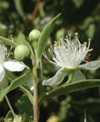

Flowers of myrtle.
MYRTLE WAS A POPULAR ENGlish female name in the early 1900s. I had two aunt Myrtles, and when I was a child I always thought the name was humorous. Not until I acquired firsthand knowledge of this beautiful plant did I appreciate why girls were named after myrtle. Because myrtle is comely and easily cultivated, it is widely planted as an ornamental shrub in Mediterranean climates.
Myrtle, Myrtus communis, is an appealing, unassuming shrub. It has evergreen leaves and under optimum conditions grows to a height of about 8 meters (24 feet). Fragrant, small, white flowers are produced in large numbers in the middle of the summer. The fruit is a small, black berry, resembling a blueberry. In some villages in northeast Syria, an apertif is prepared from myrtle fruits. The entire plant contains fragrant oil. Like several other Bible plants, myrtle is the only representative of its family in the Middle East. The eucalyptus, native to Australia and widely planted in the Middle East, is in the same family.
Myrtle is not mentioned in the Bible until the time of the captivity of the Children of Israel. The first reference is in regard to the celebration of the Feast of Tabernacles (known as Succoth): “And they should proclaim this word and spread it throughout their towns and in Jerusalem: ‘Go out into the hill country and bring back branches from olive and wild olive trees, and from myrtles, palms and shade trees, to make booths as it is written’” (Nehemiah 8:15, NIV). Interestingly, myrtle is not expressly mentioned in Leviticus 23:33–40, where rituals of the Feast of Tabernacles are explicated.

These myrtle branches were purchased in March at the Damascus market, at the time of a Muslim holy day.
Myrtle is included in Isaiah: “I will put the cedar in the wilderness, the acacia, and the myrtle, and the olive tree; I will place the juniper in the desert, together with the box tree and the cypress” (Isaiah 41:19, NASB); and, “Instead of the thornbush the cypress will come up; and instead of the nettle the myrtle will come up” (Isaiah 55:13, NASB). These verses refer to the establishment of the people in the land. As an evergreen, fragrant shrub associated with watercourses, the myrtle is a fitting symbol of the recovery and establishment of God’s promises. In Zechariah 1:8–11, a man stands in a ravine among myrtle trees, apparently enjoying their humble beauty and fragrance.
No other uses are given for myrtle in the Bible and it is not mentioned in the Quran. It was used in ancient times for production of ink (Worrell 1947) and perfume (Brun 2000). I have also been told that myrtle leaves are added to the still when making the popular Arab liqueur, aarak. A modern use is for decorating graves. During Muslim holy days, there are myrtle vendors by the Shiite shrines in Damascus. The branches are purchased for strewing on the graves of loved ones. The same practice is carried out in Lebanon. This may explain why George Post, the eminent botanist and Bible scholar of the 1800s (Musselman 2006), wrote that myrtle leaves were sold in the markets in his day (Post 1901c) without mentioning their use.
Myrtle needs more attention as a Bible reference. It is an attractive plant even when not flowering, and the entire plant is suffused with a pleasant fragrance.